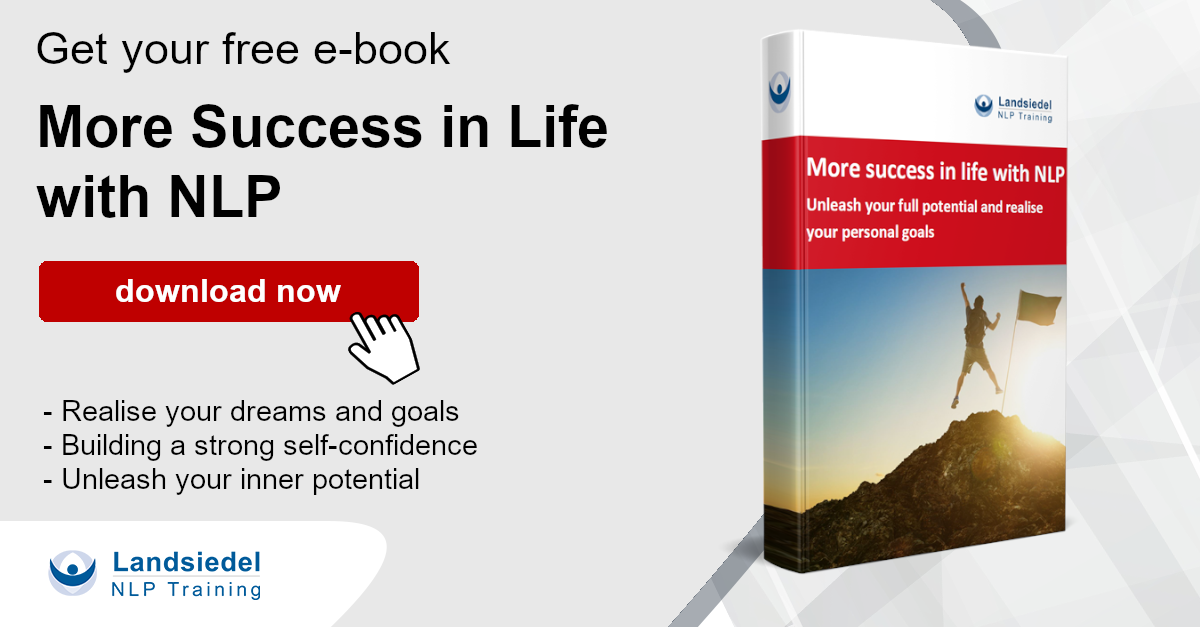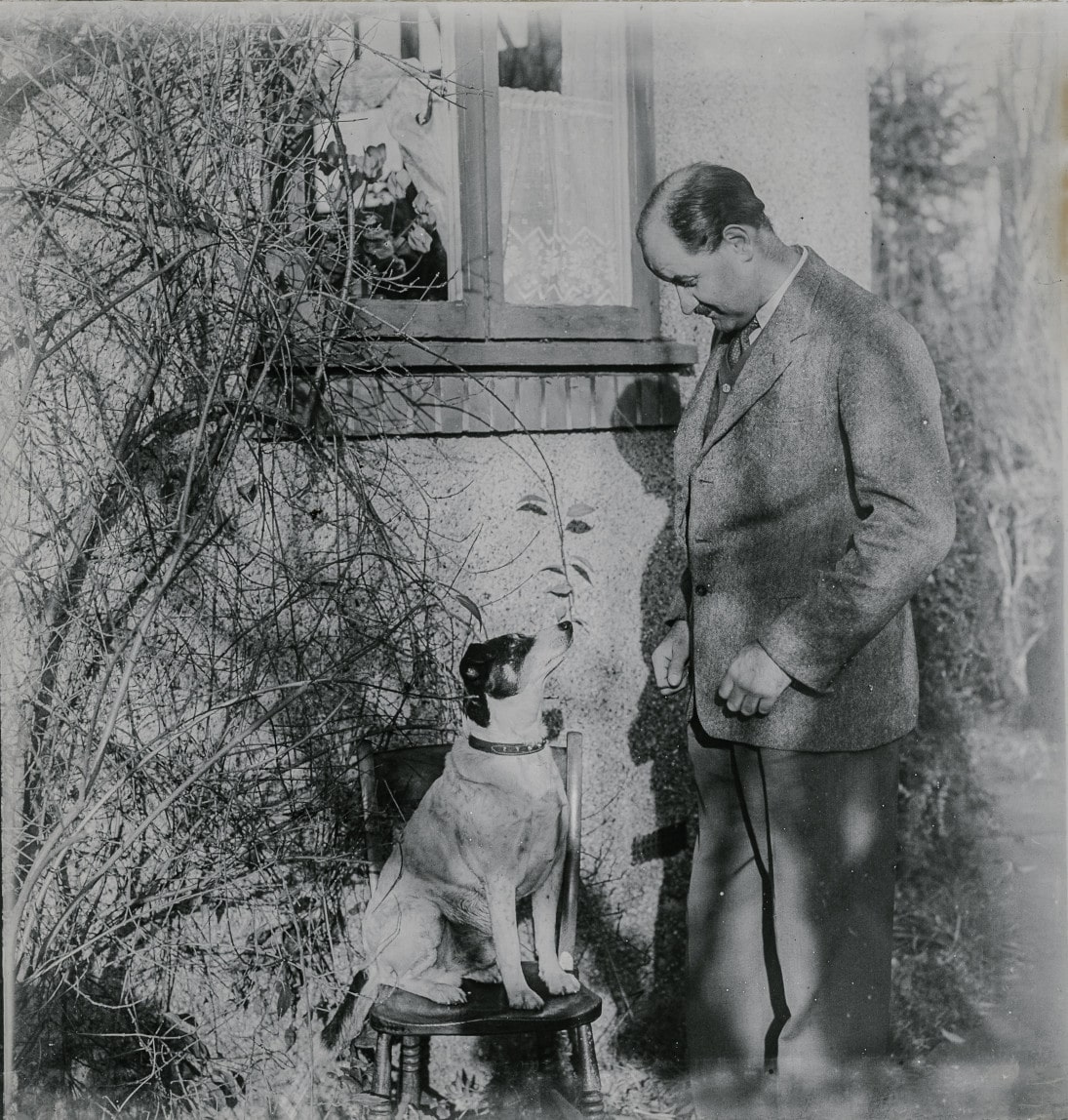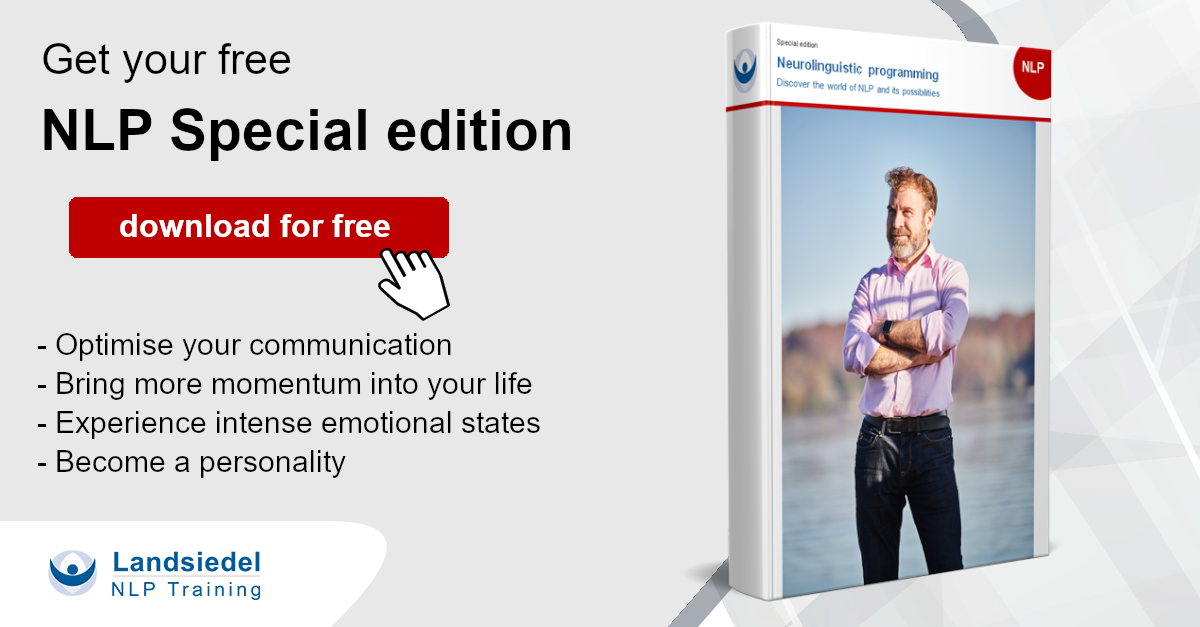Landsiedel NLP Training →
NLP →
NLP Techniques
Learning and Applying NLP Techniques
NLP techniques are available in a wide variety of forms, due to the large number of NLP application areas. They can be aimed at individuals, but also at couples and whole groups. While some NLP techniques take a few minutes, others require considerably more time.
One focus is the training of perception. Perception is a prerequisite for successful communication: only those who can see what their own words and body language trigger can react accordingly and act as needed. With appropriate language models, speech patterns and so-called representation systems a deeper contact to the interlocutor can be established.
There are techniques that give you the ability to adapt your emotional states to the requirements of a situation - indispensable not only for a better feeling of well-being with yourself, but also advantageous for appropriate communication with your conversation partner. In addition, there are techniques that can change the way we perceive our reality in order to construct it anew. In this way new meanings can be given to different situations and new ways of dealing with them.
A certain kind of NLP techniques are the strategies that control and guide human behaviour. In NLP, methods have been developed to take over the strategies of experts in order to optimise, for example, creativity, flexibility, motivation and decision-making processes. At an advanced level, students learn how to replicate human peak performance: One finds out the patterns of successful people in order to make them useful for oneself.
Top 10 Techniques
- Rapport
- Anchoring
- Reframing
- Swish Pattern
- Fast Phobia
- Core Transformation
- Disney Strategy
- Mentor Technique
- Diamond Technique
- Chocolate Pattern
Calibration

Calibration is the ability to recognise externally perceptible characteristics and to assign them to the condition. For example, after I have adjusted well to my counterpart, I can see from a subtle change in the face whether a suggestion is well received or whether perhaps further arguments are necessary.
Calibration is not pacing. Nevertheless, a fine perception, as it is necessary for calibration, is an important prerequisite for pacing. Calibrating means first of all only that I take information from the voice, the face or other body reactions. Whether I then mirror these (pace) is another matter.
Exercise for Two:
- Person A thinks of a person she likes. Person B pays attention to the physiology of person A.
- Then person A thinks of a person he does not like. Person B again pays attention to the physiology of the person.
- Then person B asks person A questions and tries to find out who the person is by looking at the physiology. Questions are " Which person has more temperament?", "Which person lives further away?", "Which person ...?".
Mirroring
Mirroring refers to physical adaptation to posture, gestures, breathing, facial expressions, movements or weight shifts, muscle tone, etc. Here you adapt like a mirror to everything you can see.
Exercise:
Mirror the body movements of other people and build up rapport with them.
Pacing
Pacing means adapting to the other person's overall visual and auditory expression. The other person is picked up where he or she stands. For example, I like to pace the speech rate, the rhythm, the pitch of the other person. Everything that belongs to mirroring also falls into this category.
Exercise:
Call a friend and pace his speaking speed and volume on the phone. Also pay attention to his favourite phrases.
Rapport

When people meet, their expressive behaviour usually adapts to each other, either consciously or unconsciously. The more positive they see the contact, the stronger their similarities in communication become. This effect can be used the other way round by mirroring the behaviour of the other person and thus building up rapport (a positive interpersonal relationship). Rapport can be created with "mirroring" and "pacing".
Exercise:
Observe on the street, in restaurants, at public events and wherever you are in the near future, whether or not there is a report between the people involved.
Anchoring Techniques
Anchoring is a conscious conditioning of a stimulus with a reaction, whereby feelings can be stored in order to recall them later. In this way one can, for example, put oneself in a resource-rich state in order to be able to cope with tasks better.
In this way an anchor can be set:
First determine the resource, the state you would like to have available "at the push of a button" and select the anchor (can be a pressure on a body part) with which you would like to call up this state.
- Remember fully associated with an experience in which you had the desired resource at your disposal.
- Activate the selected anchor just before the climax, i.e. the highest intensity of the resourceful state.
- Separator: interrupt the state, e.g. with a distracting question.
- Test: Release the anchor again to test whether it works.

Representation Systems
Representation systems describe how we perceive the world through the five senses, with each person having a different focus (VAKOG = visual, auditory, kinesthetic, olfactory, gustatory). One of the typical representation systems is the VAKOG model.
VAKOG
According to the NLP model VAKOG people use their own five sensory channels with different emphasis.
- V: Visual – See
- A: Auditive – Listening
- K: Kinaesthetic – Touch/Feel
- O: Olfactory – Odour
- G: Gustatory - Taste
Exercise:
Listen to your favourite songs and identify the different sensory words.
Eye Accessing Cues

Short, unconscious movements of the eyes in certain directions provide information about what is going on opposite. In general it can be said that on the left side information is remembered and on the right side information is constructed. Visual and auditory memories are correspondingly left and visual and auditory constructions are right. In addition, there is the recall of feelings (eyes go down) and the inner dialogue (eyes go left down). The eye accessing cues is a generalisation, which of course does not always apply. Remark: For left-handed people the sides are usually reversed.
Exercise:
Observe the eye movements of the participants during television interviews.
Reframing
"There is nothing that is good or bad in itself, only thinking makes it so." - William Shakespeare. You yourself decide what meaning you give to things by placing them in a certain framework. In so-called reframing, something is reinterpreted to achieve a change of perspective.
Reframing is one of the strongest and most frequently used concepts in NLP. The ability to see things from a different perspective is the essence of "Outside the Box" thinking. For this very reason it is worthwhile to understand and practice reframing on a championship level.
Exercise:
Which private problem can you turn into a challenge?
Six-Step-Reframing
This format is particularly suitable for behaviour and symptoms whose meaning is not apparent to the conscious mind. The 6-step programme changes unwanted behaviour by making better alternatives available. The core of the intervention is the distinction between intention and behaviour.
- Step 1: Identify the unwanted behaviour
- Step 2: Communicate with the part of you that is responsible
- Step 3: What is the positive intention behind it?
- Step 4: Be creative and develop a new behaviour
- Step 5: Introducing new behaviour for the future
- Step 6: Eco-Check
More about: Six-Step-Reframing.
Submodalities

Imagine a positive experience from your life: Enlarge this picture, mix in more colour and add tones and sounds. The submodalities allow you to quickly influence your own emotional life and get rid of annoying habits or fears.
The elaboration of Submodalities:
Person A goes into a positive state. Person B asks about the submodalities. Person A then goes into a less pleasant state, which he later wants to get rid of. Person B asks about the submodalities. Now the submodalities of the two states can be compared. Which differences become visible?
The following questions can be asked:
- Visual: What do you see? Are you associated or disassociated? Is it a picture or a film? Rather near or far?
- Auditive: What do you hear? Are they voices, noises, sounds or silence? Where do the noises come from? Loud or soft?
- Kinaesthetics: Which body sensations do you feel? Where in the body do you feel them? Do you feel warm or cold?
Swish Pattern
Would you like to resolve an unwanted behaviour right now? The Swish pattern can be used to change unwanted habits and build strong positive motivation. With the standard Swish, the submodalities: size, brightness and distance. This works very well in many cases. In brief, with Swish, the target image becomes larger, brighter and comes closer and the unwanted image becomes smaller, darker and moves away.
- Step 1: Find an unwanted behaviour
- Step 2: Imagine the triggering image (associated). What immediately precedes the unwanted behaviour?
- Step 3: Create a target image (dissociated). How can someone from outside recognise that you are a person for whom ... is no problem?
- Step 4: The Swish. Make a Swish with the two pictures. Start by making the triggering image of the context large and bright. Then place a small dark picture of the target in the lower right corner. The small dark image will become larger and cover the first image completely, which will fade and shrink as fast as you can say "Swish".
- Step 5: Repeat 7x.
- Step 6: Now imagine the first picture. What happens?
Fast Phobia

With this NLP technique it is possible to eliminate phobias within a very short time. Imagine a phobic situation dissociated as a black and white film. Now play the film in colour and associate backwards. This will dissolve the phobia after repeated use.
- Step 1: Now think of a situation in which you have reacted full of stress/fear.
- Step 2: Now go back out of the state.
- Step 3: Imagine you are at the cinema and would see a black and white film of this situation with a double of you.
- Step 4: Imagine the inner film and how your double slowly approaches the critical situation and then experiences the stressful event.
- Step 5: At the worst point you now pause the film, as if you were pausing a video film and a still image appears.
- Step 6: Now go into the film (associated). You are now in the situation and see the film through your eyes with everything that can be seen in the situation. Now bring colour into the picture.
- Step 7: Now let the film run back quickly until you are safe again. Now open your eyes.
- Step 8: Repeat this format from 3-7 a few times and then test if you are still able to get a stress reaction with the idea of 1. If so, go through the format again. If not, test the result in reality on occasion.
Meta Model
Language is not only the basis for clear communication, but also for quick and targeted change. With the meta model of language you acquire one of the leading language tools of our time and can become a master of spoken language. The meta model of Language is a collection of numerous language patterns and question types. You can find the collection of language patterns here: Meta model.
Exercise:
Practice the meta model on your own by writing down a positive or negative experience and then meta model yourself: mark patterns in the text, question them and give the respective answers.
Milton Model
The milton model is a kind of inversion of the meta model. While the meta model is used to concretise and specify statements, the milton model tries to be more elaborate and vague. This unspecific language is used to trigger trance states and help the listener to gain access to his inner resources. With the help of these speech patterns of the Milton Model you can perform a beautiful relaxation trance. However, you can also use the Milton model in business contexts, e.g. in lectures to put the listeners into nice emotional states or in sales talks to create positive associations with your own products.
Time Line

The Time Line is a visual symbol, an NLP technique, through which you can code your past, present and future in time. It serves e.g. for the planning of goals. How does your timeline run? Do you live in time or through time? Use your own timeline to systematically plan your goals and gain clarity for your future.
How do we code memories in some way so that when we have two different memories we know immediately which one is earlier and which one is later? How does our brain make the difference between future and past? The basic hypothesis is that our brain spatialises temporal differences. This has been empirically confirmed in a great many people. The discovery of the timeline enables us to make a large number of changes in a very short time.
Trance
A trance state is a different state of consciousness than the usual one. Usually one is rather immobile and directs one's attention inwardly to an innerly called or generated experience. The trance state has nothing to do with sleep, but physiologically it cannot be distinguished from meditation and relaxation. However, hypnosis cannot be equated with relaxation, as trance phenomena can be produced without physical relaxation and, unlike relaxation, hypnosis cannot be trained. Nevertheless the trance state is not unique and is not completely different from everyday trances of the waking state, such as highway hypnosis or going into a good book.
A method for inducing trance, the 5 4 3 2 1 method:
The method is based on language and is used with pacing and leading. At the beginning five statements are "paced" for the immediate experience of the person. Example: "You are sitting on the chair", "You hear my voice", "Your hands are resting on your thighs", "Your eyes are closed", "You are breathing". Then comes a leading statement, which guides the person towards a goal: "You begin to relax more and more". After that it continues with four pacing statements and two leading statements.
Here is the further overview:
- Step 1: 5 pacing statements + 1 leading statement
- Step 2: 4 Pacing statements + 2 Leading statements
- Step 3: 3 Pacing statements + 3 Leading statements
- Step 4: 2 Pacing statements + 4 Leading statements
- Step 5: 1 Pacing statement + 5 Leading statements
Notice:
With the 5 4 3 2 1 method, always go from outside to inside and from pacing to leading.
SMART Method
Maybe you know the following situation. You have a goal in mind, start working towards it and after a while you realize that something about it is not working. Goals should be formulated in a specific, measurable, attractive, realistic and timed way so that they can be achieved more easily and quickly.
- S(pezifisch): A goal should be specific, i.e. exact and precisely formulated.
- M(edible): There should be some measurability so that progress is visible.
- A(ttractive): The destination should be attractive for you.
- R(ealistic): The goal should be possible through physical or other laws and basic personal characteristics.
- T(erminiert): Set a date by which the target should be reached.
Practice:
Is there something in your life that you always wanted to do but never really managed to do? If you have found something, formulate a well-formed goal that is specific, measurable, attractive, realistic and timed. Write the goal on a piece of paper and hang it up where you often see it.
Strategies
Strategies are specific plans of consciousness that help you organise your thoughts and behaviour in order to accomplish certain tasks. There is, for example, the Walt Disney strategy or the tote model.
Each strategy also includes certain attitudes and beliefs. For example: "Being successful is possible and important for me.
Strategies are like the recipe we use to bake a cake: What is essential are the ingredients, what is decisive is the quantity of each ingredient (whether one egg or ten) and the order in which we put them together.
Perceptual Positions 1-2-3
Do you perhaps have a conflict with someone right now? With your partner or with your parents, with children, with a friend or with colleagues at work, so that you cannot look forward to the next encounter, but that there is always something negative going on? Through the three perceptual positions you can learn to perceive a situation from different perspectives (ego position, you position, meta position) in order to resolve this conflict. For this technique the other person does not have to be present.
Parts Negotiation

Do you know the feeling that you are torn between two things? You want one but also the other and you have the feeling that you cannot find a way out? Part Negotiation is an NLP technique in which two or more parts (subpersonalities) with different goals are connected.
- Step 1: Find the problem
- Step 2: Separate the parts
- Step 3: Characterise the parts and find their positive intentions
- Step 4: Let the parts communicate with each other
- Step 5: Finding the higher common purpose
- Step 6: Negotiating new behaviour
- Step 7: Eco-Check
- Step: 8 Future Pace
Neurological levels / Dilts pyramid
The neurological levels are interconnected levels of thinking: environment, behaviour, skills, beliefs/values and identity. Through these levels it is possible to find out where a problem or a goal is located in order to eliminate or achieve it. Robert Dilts designed the individual levels of the model of the Dilts pyramid in the mid 80s. His background idea was to develop an instrument that helps people to better understand themselves and their environment. The Dilts-Pyramid developed by Robert Dilts can help you to find out on which level you are currently and which level you should enter in order to change successfully. With the help of the Dilts-Pyramid you can develop yourself as a person in many ways.
Beliefs
What do you believe in? Are there any thoughts that distract you from your goals? Everybody knows that voice in your head that sometimes says: "You can't do it" or "You can't do it! A belief is the linguistic expression of something someone believes what someone believes to be true. In NLP, beliefs are an expression of inner models, which every person continuously designs and must constantly design in order to orientate himself in the world. Other terms for this are: Beliefs, attitudes, Belief, opinions.
Examples: „I'm too young.“, „I'm too old.“, „I don't have enough money.“, „I don't have enough education.“
Find beliefs: What beliefs do you have? What do you think about life, your identity, your career, work, time, money, love, etc.? Often these beliefs start with the phrases "I am...", "Life is...", etc.
Change beliefs: How must I perceive the world in order to get what I want? Which acceptance supports me best in achieving my plans and goals? What beliefs does the person you want to be have?

Core Transformation
Core Transformation is about identifying behaviour, feelings and reactions that you don't like about yourself, and using them to embark on an amazing and uplifting inner journey into the depths of your being.
Examples:
- 1. Calm in Being
- 2. Inner Peace
- 3. Love
- 4. Being Okay
- 5. Oneness
10 Steps of Core Transformation:
- Step 1: Select part to work (experience the part, acknowledge it as belonging, welcome it)
- Step 2: Discover your intention: „What do you want?“
- Step 3: Discover the chain of results
- Step 4: Reach core state and enjoy
- Step 5: Revise the results chain using the core state
- Step 6: Let a part become an adult
- Step 7: Fully integrate the part into your own body
- Step 8: Revise the results chain using the adult part
- Step 9: Look for opposing parts
- Step 10: Generalisation of the timeline
Disney Strategy

This macro strategy goes back to Walt Disney, the co-founder of the world-famous Disney Company. Disney was a person with very distinct dreams and visions. He separated three different phases of objective setting and distinguished them precisely from each other both in space and time. These phases or positions were: The creative dreamer, the realistic planner and the constructive critic. For each of these three positions, Walt Disney had a different space, which also supported him through his equipment to reach a mental state favourable for the respective position.
- Step 1: Mark three different places in the room.
- Step 2: In the next steps, run through the individual positions relatively quickly to get a first impression of this strategy.
- Step 3: Take up the position of the dreamer.
- Step 4: Remember a situation where you were creative and imaginative and develop creative ideas
- Step 5: determine the position of the dreamer and switch to pull through for a short moment.
- Step 6: Now take the position of the realistic planner. Choose one of the ideas of your dreamer that you want to plan now. How could you realise this idea?
- Step 7: Leave the position of the planner.
- Step 8: Take the position of the constructive critic. Remember a time or situation when you were constructive and critical, when you recognised obstacles and objections early on and knew exactly where the strengths and weaknesses of a plan lay. Look at the result of the dreamer and the planner. Feel inside and develop a feeling for the plan. Where is something missing? What has not yet been taken into account? Can you reach your goal with this plan?
More about: Disney Strategy.
Future Pace
This is an NLP technique by which the results of a change process can be transferred into the future. The process by which a person explores their ideas about the future for a particular context, task, etc. Future Pace is a standard procedure of NLP at the end of change techniques. A positive vision of the future after an NLP intervention is an indication that the desired change can occur naturally and automatically. A negative vision of the future is an indication that the NLP intervention used will have little effect on actual behaviour in the future.
Eco Check
A standard NLP technique that occurs as a separate step in very many techniques. The check is: „Is there anything that speaks against experiencing this situation differently from now on?“
Mentor Technique
This format is about using our inner potential and the question: How can we free ourselves from our limitation in thinking and instead expand our thinking to include new possibilities?
The format uses virtual mentors who enable us to take a change of perspective and thus broaden our own horizons. It tickles the hidden wisdom within us through our imagination to get answers.
- Step 1: Find a problematic situation
- Step 2: Live through this situation
- Step 3: Leave this situation again and reflect on the 2-3 mentors. A mentor is a counsellor, a consultant, a benevolent or wise friend. Your mentors can be both real people, such as friends, acquaintances or role models, and fictional people, such as fairy tale characters or characters from films
- Step 4: Put yourself in the place of each of your mentors one by one
- Step 5: If you have left the position of the last mentor, think again
- Step 6: Next time, try to follow and implement the advice of your mentors
Diamond Technique

The special thing about the Diamond technique is that problems are not solved with this technique, but solved. Objectives are also not simply to be achieved with this technique, but rather to be considered in greater depth. The Diamond Technique is a very nice addition to other NLP techniques. It can be used as a problem solving technique as well as a creativity technique.
- Step 1: Determine the corresponding goal (well-formedness!)
- Step 2: What do problem and goal have in common?
- Step 3: What is beyond the problem and goal?
- Step 4: Determine for each of the four points what is enabled and what is prevented.
- Step 5: Then we turn back to the original problem and the desired objective.
Exercise: Take a target from you and go through the Diamond.
Metapher
Metaphors are incredibly important for communication and personal understanding. Since ancient times metaphors have been used as a means of teaching and changing conceptions, ideas and attitudes towards life. Shamans, philosophers and prophets have intuitively recognised the inherent power of metaphors and used them.
- Step 1: Identify the problem. What is at stake?
- Step 2: Determine the target. What does the person who has the problem want to achieve?
- Step 3: Select the appropriate content level. Find a content level that could reflect the problem structure, e.g. heaven of the gods, kingdom of demons. The content level must be interesting for the addressee of the metaphor.
- Step 4: Reflect the problem and the objective in the content levels. The story must be structurally similar to the problem.
- Step 5: Designing the path to the goal.
- Step 6: Writing the metaphor.
- Step 7: Check the metaphor ecological. Does the goal fit into the context of a person's life without negative consequences?
- Step 8: Include feedback instructions. Incorporate possibilities to provoke physiological signals.
- Step 9: Refine the metaphor. Insert improvements.
Chocolate Pattern
A pattern for doing something you don't like to do in itself, but need to do, with more motivation. A very useful use of this pattern is to change your feelings about tasks you have congruently chosen to do, but which you do not currently enjoy doing. If you have congruently decided that it is important to do it, you might as well enjoy it!
- Step 1: Find the Problem
- Step 2: Motivating Image (associated)
- Step 3: Image of the Task (dissociated)
- Step 4: Eco-Check
- Step 5: Iris pattern. See the image of the task in front of your mind's eye, with the motivating image directly behind it. Quickly open a hole in the front picture so that you can see the picture behind it through this hole. Quickly open the hole as far as you need to go to achieve a full emotional response to the motivating image. Now let the hole shrink quickly. But only as fast as you can maintain the emotional response to the motivational image
- Step 6: Repetitions
- Step 7: Test. The aim is to combine the feeling of the motivational picture with that of the task picture
More about: Chocolate Pattern
Worst Enemy

Using this technique you can shrink your Worst Enemy so that he loses his threatening effect.
- Step 1: Think about a person in whose presence you have felt anxious, insecure, inhibited, nervous and similar. Where and how do you see the picture in your "mind's eye"? Is it further away or rather in front of your nose? Does the person in your imagination have the real size or does he or she seem bigger? What feeling arises in you when you think of this person? …
- Step 2: Now imagine a small black and white television set a few metres away from you and on the floor at the bottom left.
- Step 3: See the picture of this person now in the small black and white TV. What changes in your perception when you see this person as a small black and white picture on the bottom left of the floor?
- Step 4: Now, with your eyes closed, let the image of the person reappear in your mind's eye in the original way. Then let the image of the person shrink, and see it as in the small black and white television, a few metres away from you on the lower left. Then open your eyes.
- Step 5: Repeat step 4 five to eight times
- Step 6: Now imagine that you would meet this person. How do you experience the situation now?

